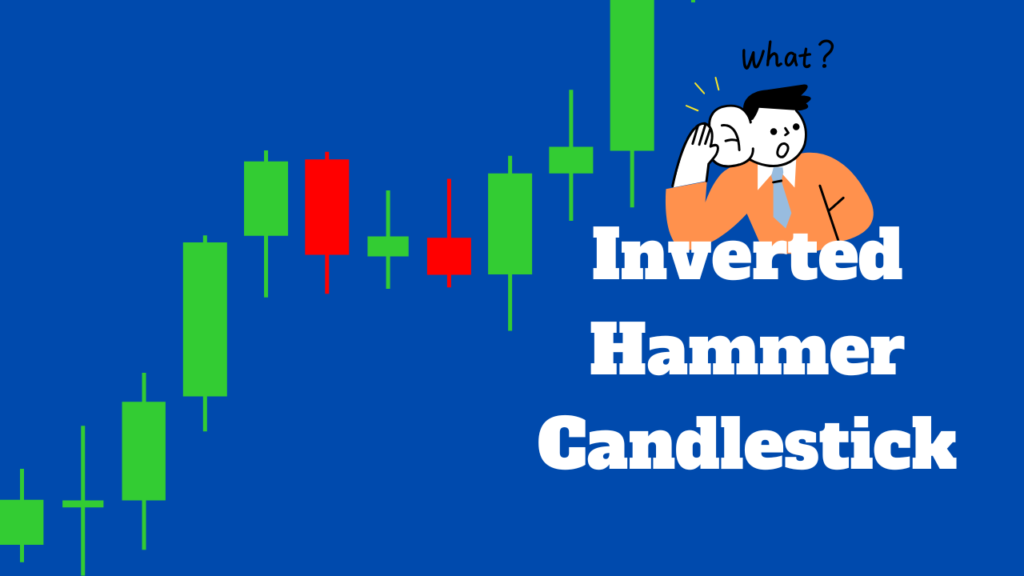The inverted hammer candlestick is a popular and essential pattern in technical analysis, helping traders identify potential reversals and changes in market trends. Whether you’re just starting out in trading or have been involved for some time, understanding this pattern can greatly enhance your ability to make informed decisions. In this comprehensive guide, we’ll break down the inverted hammer candlestick pattern and explain its significance in various market conditions, focusing on its meaning, the difference between a green and red inverted hammer candlestick, and its role in an uptrend or downtrend.
What is an Inverted Hammer Candlestick?
The inverted hammer candlestick pattern features a small body with a long upper shadow and little or no lower shadow. It often appears after a downtrend, signaling a potential reversal or the start of a new bullish trend. This pattern is called an “inverted hammer” because its shape resembles an upside-down hammer with a small body and long upper wick. The long upper shadow indicates that bulls attempted to push prices up during the trading period, but bears pulled the price back down by the close. Despite the bearish pressure, the fact that the candlestick closes at or above its opening price indicates that a reversal is likely. However, it is important to note that the inverted hammer in itself does not guarantee that a reversal will occur. Traders usually look for confirmation from the next candlestick before taking action.

Inverted Hammer Candlestick
Inverted Hammer Candlestick Meaning
The inverted hammer candlestick holds important meaning in technical analysis, particularly in identifying potential trend reversals. When it appears at the bottom of a downtrend, it may be a signal that the price is close to a key turning point, with the potential to move into an uptrend. Bulls were able to push the price up during the session, even though bears managed to pull it back down, indicating that selling pressure may be weakening. This pattern is particularly important when it appears at the end of a long-running downtrend, signaling that the market may be ready to rebound. However, the inverted hammer alone is not enough to make an investment decision. It must be accompanied by a confirming bullish candlestick (e.g., a strong green candlestick) on the next trading day to reinforce the reversal.
Inverted Hammer Candlestick in an Uptrend
The inverted hammer candlestick can also appear during an uptrend, although its interpretation is slightly different. When it appears after a strong uptrend, it is usually referred to as a shooting star. While both the inverted hammer and shooting star look similar, the main difference is in the context in which they appear. In an uptrend, the shooting star inverted hammer candlestick usually signals that market momentum is waning. The long upper shadow indicates that bulls tried to push prices higher, but bears were able to regain control and push prices back down. If there is a confirmation candle after the shooting star – a red or bearish candle – then the likelihood of a reversal to a downtrend is high. Traders often look for a break below the low of the shooting star to confirm a change in market sentiment.
Green vs. Red Inverted Hammer Candle
The color of the inverted hammer candle can provide additional information about the strength of a potential reversal. Both green and red inverted hammers can appear, and understanding the subtle differences between them is key to correctly interpreting the market.
Green Inverted Hammer Candle: A green inverted hammer candle occurs when the closing price is higher than the opening. This suggests that the bulls managed to push the price up during the trading session, and even though the bears took control in the end, the fact that the candle closes above the opening price shows bullish strength. This is generally seen as a strong signal that the trend may reverse, and traders can expect an uptrend.
Red inverted hammer candle: A red inverted hammer candle occurs when the closing price is lower than the opening. In this case, despite the upper wick showing an attempt by the bulls to push prices higher, the bears were able to dominate, pushing the price lower. The red inverted hammer indicates hesitation or weakness, and while it may still signal a potential reversal, market sentiment is not as strong. A confirmation candle, such as a green candlestick following the red inverted hammer, would be needed to signal a true reversal.
Bearish Inverted Hammer Candlestick
While the inverted hammer candlestick is most commonly a bullish reversal signal, it can also be bearish in certain contexts. If the pattern appears during an uptrend or at a price level where the market is experiencing strong resistance, it may be a sign that the uptrend is losing momentum. When this happens, the inverted hammer can be considered a bearish inverted hammer candlestick, which suggests that the bulls are weakening and the market may soon turn into a downtrend.
For example, a bearish inverted hammer that occurs after a prolonged uptrend is often interpreted as a warning signal. Bulls attempted to push prices higher, but the fact that the price closed lower indicates that bears are regaining control. A confirmation candle, such as a red candlestick that closes below the body of the inverted hammer, strengthens the bearish signal and suggests that a downtrend may follow.
How to Use the Inverted Hammer Candlestick Pattern in Your Trading Strategy
To successfully incorporate the inverted hammer candlestick pattern into your trading strategy, it is important to keep the following key points in mind:
- Wait for confirmation: The inverted hammer alone is not enough to confirm a reversal. It must be followed by a confirming candlestick – usually a strong bullish candlestick (for a potential uptrend) or a bearish candlestick (for a downtrend).
- Context matters: The location of the inverted hammer on the chart plays an important role. When it appears after a downtrend, it is more likely to signal a potential bullish reversal. If it appears in an uptrend or near resistance levels, it may indicate that the market is losing momentum.
- Volume considerations: Volume can help validate the significance of the inverted hammer. High volume during the formation of the inverted hammer often indicates strong conviction from market participants and makes the pattern more reliable.
- Use with other indicators: Combine the inverted hammer with other technical indicators such as moving averages, RSI or MACD for better accuracy in predicting market trends.
The Bottom Line
The inverted hammer candlestick is a powerful tool in the trader’s arsenal, providing valuable information about market sentiment and potential trend reversals. Whether you are facing a green inverted hammer, indicating potential bullish momentum, or a red inverted hammer, indicating a less certain reversal, understanding how to read and interpret this candlestick can greatly improve your trading decisions. By considering the Inverted Hammer candlestick in uptrend or downtrend contexts and waiting for confirmation from subsequent candles, you can use this pattern to anticipate market changes and adjust your strategy accordingly. Like any technical pattern, it is important to use the Inverted Hammer in conjunction with other analysis tools to increase the accuracy of your forecasts and minimize risks. Happy trading!

